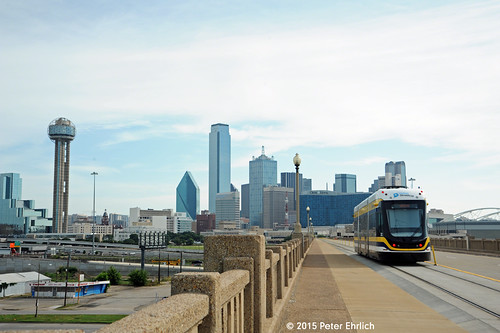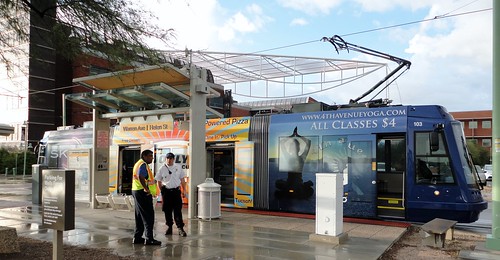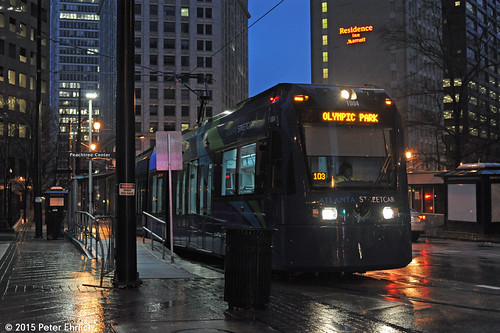DC streetcars move to simulated service: passenger service expected within a couple months: DC streetcars part 1
Just after I listed the ongoing trials and tribulations of DC's launching of streetcar service as #6 in the "Top DC area transportation stories of 2015, "the city transportation department announced that the streetcars were going to start simulated service ("DC Streetcar Pre-Revenue Operations Scheduled to Begin December 16, 2015," press release), the last testing step before beginning operation.
This testing phase will last 21 days, followed by evaluation and further approvals.
This led to a spirited discussion of the issue in a private e-mail group, and it's worth pulling out some of the points.
Almost there... A streetcar sits on the rails along H Street NE near the intersection with 4th Street in Washington. (Eva Russo/For The Washington Post)
It sure is taking a long time. While the streetcar has been a debacle, planning started in 2003, not 2000. The city didn't make a commitment til 2005, when they agreed to install tracks in the street as part of the streetscape reconstruction. That didn't happen for a few more years. Still, they bobbled the program many times over the years, especially by not designing the power infrastructure in advance of the streetscape reconstruction.
Right: development map along the Cincinnati streetcar route. I wish I had the ability to produce quality graphics. No one has created a similar graphic rendition along the H Street streetcar route, development announced, underway, or soon to be announced that is directly attributable to the streetcar is approaching $750 million.
Cincinnati. It's ironic that the Cincy program will go operational 4 years from start of construction. They are in testing mode now, although they aren't committing to revenue operation til 9/2016. The reason it's ironic is the manager of the effort in Cincinnati was John Deatrick, the former chief engineer for DC's Department of Transportation. He also spearheaded "around the turn of the century" a systematic repaving program for the alleys.
Seattle. DC and Seattle started streetcar planning at the same time, in 2003. Their first line went operational in 2007. Their second line is just about operational now--delays are due to problems on the streetcar manufacturing side, otherwise the line would already be in service.
That says a lot. I don't know about the launch of the new line in Seattle, but the first line was launched successfully because they hired the same firm that did the launch of and (still) operates the Portland Streetcar.
 Flickr photo of the Dallas streetcar on the Trinity River Bridge by Peter Ehrlich.
Flickr photo of the Dallas streetcar on the Trinity River Bridge by Peter Ehrlich. The testing and safety requirements are the same for all streetcar operators. The fault in getting it operational isn't the fault of regulations from FTA and others, it's almost completely and entirely failures by DC Government, primarily DDOT, but more recently a lack of commitment from elected officials (and therefore, the city's business community is indifferent too). Note that the Dallas streetcar went to revenue operation last year, after only 6 weeks from receipt of the vehicles.
In response to streetcars vs. buses, vs. trams/light rail vs. heavy rail, etc. There is a place for streetcars in the transit network. I was re-reading a piece I wrote last year, and I have to say, it's damn good [it is reprinted in the next entry]. It discusses the place of the streetcar in a city like DC as transit, not just economic development, but focused on intra-district mobility.
FWIW, I was a super strong proponent for a long time. Now I think it's a distraction, that DC should have focused on the separated blue line, given the limited resources. That being said, there are equity issues, it's better to improve transit service for the transit dependent, etc.
Will ridership increase in streetcars over bus? The thing about the expectation of a ridership increase of 40% of streetcar over bus, the reality on H St. might be different. The H St. buses already get between 14K and 15K daily riders. I don't see 4-5K new daily riders because of streetcar (especially because they won't be run at the same frequency). I don't think there are that many trips capable of capture.
No Sunday service. .. not to mention that DDOT announced the streetcars will not run on Sundays.
That to me indicates that as a transit service, it's not being taken fully seriously. From the Washington Post article "District says streetcars starting final dry run but still need safety sign off":
A spokesman for the District Department of Transportation said Tuesday that when the doors open to the public, streetcars will run six days a week, with no passenger service after 2 a.m. on Sundays. The city had already rolled back the frequency of daily service, which officials say will run every 15 minutes instead of every 10 minutes.With regard to the streetcar running in mixed traffic: yes, streetcars (and buses) should be prioritized, but we already know that thinking in DC is backwards as it relates to sustainable mobility (walking, biking, transit).
“Going with six days provides a recovery day for the system. We’ll have a day we can perform track and vehicle maintenance without impacting service,” said DDOT spokesman Terry Owens, adding that officials think such an arrangement “will enhance the reliability” of the 2.2-mile line. “We want to deliver a system that’s safe, sustainable and makes efficient use of our resources. It’s a more conservative approach. But we will always have the option of expanding the days of operations.”
Likely the majority of trips in the city are conducted by sustainable modes, but the mobility priorities of the city do not recognize it (as I wrote before, DC's politics are dominated by the greater automobile-centricity of the outer city). That's an impetus behind my annual "maintenance of way" post for winter weather in the context of the walking-transit-biking city--if the city is pro-sustainable mobility, why do snow clearance practices privilege the motor vehicle?
DC's implementation problems hurt the case for streetcars and transit elsewhere. One of the participants (a railroad planner in the south) wrote:
this project is being hailed by all the anti-rail critics as an example of what could happen to "X" community if "X" community pursues this type of project. Of course, if you believe the Republicans, no one in the hinterlands of the USA believes Washington can do anything right anyhow.I responded:
The other thing because it is taken so long in DC (I used to promote streetcar service in DC by saying "why wouldn't you want to be the first place for modern streetcar to be implemented on the East Coast?" but Atlanta beat us to it by more than one year) and because of how rail is like fairy dust in bringing out all the opponents, including the latent automobility proponents -- by latent I mean they live in the city and so you'd think they would be predisposed to support transit, but it seems not to be the case -- it makes it f*ing hard and poisons the entire issuespace for transit.
Do people criticize streetcars in part because of how they have been associated with Portland and its reputation as a green-progressive-alternative place? Image: Portland.
I wonder if it's worth it. How many of these kinds of articles and editorials in the local newspaper (e.g., "Another wasted year for D.C.’s streetcar to nowhere," Washington Post) can transit withstand?
It's easy for media to jump on the bandwagon and criticize transit, considering how dependent they are on the automobile industry for advertising revenue.
But it's sick for me to be pushed to thinking that it would have been better not to do streetcars because the city wasn't up to the challenge of being able to implement it, that it's easier to drop it.
It's not just DC. It's Arlington with the streetcar, although there it was people in North Arlington who already have subway not caring about improving transit access and equity for south arlington. And then all the b.s. in Montgomery County/Chevy Chase with their opposition to light rail, which almost, but not quite scuttled LR there.
But other areas benefit greatly from streetcar, so DC shouldn't be an outlier. Besides the streetcar examples of Dallas, Portland, Seattle, Salt Lake City, San Francisco (which is creating a "new" heritage streetcar line, the E Embarcadero line, with new track and some light rail routing and it will enter full-time service next year), and Seattle, all of which are comparable to DC, I forgot to mention Tucson.
 Tucson Sun Link streetcar. Flickr photo by Larry Synerson.
Tucson Sun Link streetcar. Flickr photo by Larry Synerson.Tucson. According to a suburban town engineer I met a conference a couple months ago, the Tucson streetcar has been electric already (it's been operating for 15 months or so) in terms of resuscitating and repositioning Downtown Tucson as an exciting place to be, to invest, to live, etc.
Orange County, California is moving forward with a streetcar in Santa Ana although of course there is opposition.
But when I first learned about the OC Streetcar project, it made me think of streetcars as an important "priming" and (re)positioning device--not that this is a new realization--for communities not capable of supporting heavy rail, streetcar service is a way to help communities reposition for economic and residential activity in the 21st century vis a vis sprawl,.
This is comparable to the piece I wrote in Spring 2011 making the point that people focused on "the Silver Line and Dulles access" missed the point, it was really about making more of Fairfax County and now Loudoun County relevant in terms of 21st century expectations of how to live, work, and get around.
Fairfax didn't care all that much about the airport, but about making more of its property eligible for federal leasing, attracting TOD, shifting mobility primacy from the car, at least in the Silver Line catchment area, etc.
Orange County has Metrolink railroad commuter service, but it will never get light rail probably, and never ever will get heavy rail. Streetcar is a way for cities like Santa Ana in Orange County to remain relevant and competitive in the context of transit expansion in Los Angeles County.
FWIW, a lot of the area in Fairfax County that is poorly served by transit generally and heavy rail specifically, especially automobile-dependent industrial space/office space, is in bad shape. There are eminent REITs deeding properties back to their mortgage holders, etc. In. Fairfax. County. in 2014/2015.
Little Rock/North Little Rock is another example. There, the recent I-30 expansion proposals aimed to destroy a necessary bridge for the streetcar ending service in the eastern section of the line and the State Department of Highways and Transportation did not propose taking responsibility for replacing it (like what happened to the Seattle Waterfront streetcar which lost its maintenance yard due to the Seattle Art Museum sculpture garden, and the SAM wasn't required to replace it, and they junked the line).
Negative public response appears to have forced them to change their plans, to keep the full streetcar line in operation.
Heritage streetcar at River Market in North Little Rock.
(Tacoma , Washington also has streetcar service, but it hasn't been particularly successful at spurring revitalization. I haven't seen the city or the service, so I can't offer scintillating analysis on why this is so. In large part it's because increasingly, agglomeration benefits connote to locating in Seattle. One example is how a large firm, Russell Investments, relocated to Seattle, when it had been the shining example of business success in Tacoma.)
MAJOR REALIZATION FROM THE THREAD. H Street is the only area in Washington DC outside of catchment areas served by Metrorail stations that is experiencing the construction of buildings taller than 4 stories. It's pretty clear this is because of the streetcar. More on this two posts from now.

Atlanta streetcar leaving Peachtree Center at night. Flickr photo by Peter Ehrlich.
Labels: government oversight, provision of government services, streetcars, transit and economic development, transit marketing, transportation infrastructure, transportation planning









4 Comments:
"H Street is the only area in Washington DC outside of catchment areas served by Metrorail stations that is experiencing the construction of buildings taller than 4 stories. It's pretty clear this is because of the streetcar."
Is it? How many other areas in the city are even zoned to allow construction of 4+ stories that aren't already close to Metro?
For H Street, the original sin was putting in the tracks during the Great Streets project. A well-intentioned idea, but the tail has been wagging the dog ever since.
So many issues have come out of that choice. It set the streetcar on a path (both in terms of design as well as governance) that brought us here today.
"That to me indicates that as a transit service, it's not being taken fully seriously."
I think the opposite is true. This shows that it is being taken seriously. This decision is the logical outcome of a real focus on operations. Given the maintenance facility is still under construction; given that they only have 5 operational vehicles (they need at least six for 10 minute headways, and probably need more based on traffic congestion and run times); this decision shows a kind of focus on operational elements that we haven't seen before.
It's also not a decision they're making because they want to, it's a decision that's the only logical outcome after the decisions of the past.
"The testing and safety requirements are the same for all streetcar operators. The fault in getting it operational isn't the fault of regulations from FTA and others, it's almost completely and entirely failures by DC Government, primarily DDOT"
This isn't quite true.
Yes, the safety requirements for streetcars in other places is the same. However, the governance context is different.
Transit Safety oversight is run through State Safety Offices (SSO). SSOs are housed in State DOTs. They're separate from transit operators to ensure a degree of independence.
In DC, DDOT can't be the SSO for the streetcar because DDOT is also the operator of the streetcar. (DDOT is a participant in the SSO for WMATA, the Tri-state Oversight Committee). That means that DC had to create, from scratch, a new SSO in a place completely unfamiliar with transportation safety oversight, DC Fire and EMS. And that creation of the governance around transit has taken a great deal of time.
There are two sites where tall buildings are being constructed outside of transit catchment areas. I will list them in the follow up post. But they clarify the way I should have stated the point: on streets with the same kind of zoning conditions, with some exceptions, buildings this tall are not being constructed outside of the transit catchment area. That's definitely true for Georgia Avenue.
It's complicated by the reality that a lot of the streets with these conditions are already built out (e.g., Wisconsin Avenue or Connecticut Avenue for the most part, 16th St., etc.).
your other comments are pretty deep... I agree about path dependence on the tracks. Still, the necessary "follow up" that was required should have also been put on the map in terms of project development and management.
It's not like the streetcar is running in Anacostia, and I was at a WMATA regional bus conference in late 2005 when a DDOT person said with great certainty that the streetcar would be running there in 2007.
I guess I see your point about reliability and the limited number of vehicles.
2. WRT the SSO, I see your point about the regulatory and separation issues. I guess I would say there was the time to create the office in the period since the Fenty Administration renewed the emphasis on streetcars, but likely the SSO issue wasn't a primary focus, and later administrations may have had different priorities.
anyway, these are all about critical path issues in Project Management. Key, important issues.
Do you think we ("the city") could have done better or this was the best we could do?
regarding the blog entry discussion of Fairfax County, this article states that Fairfax has 20 million s.f. of vacant office space. Likely it's mostly located outside of Metrorail corridors.
http://www.bizjournals.com/washington/morning_call/2015/12/fairfax-county-takes-aim-at-filling-vacant-office.html
Post a Comment
<< Home